Economic Principles Report
VerifiedAdded on 2020/01/28
|12
|2835
|133
Report
AI Summary
This report delves into fundamental economic principles, starting with an introduction to the study of production and distribution of goods and services under resource constraints. It then tackles key concepts such as opportunity cost, illustrated through a case study comparing Rachel and Monica's pizza and coffee production. The report explains absolute and comparative advantage, demonstrating how trade can benefit both parties. The concept of marginal benefit is explored, using examples to clarify its meaning and relationship to the law of diminishing marginal utility. The report further analyzes the interplay of supply and demand, using the example of video rentals and movie theaters to show how market dynamics affect prices and scarcity. Finally, it differentiates between scarcity (a long-term condition of limited resources) and shortage (a temporary imbalance between supply and demand), using Melbourne's water restrictions as a case study. The report concludes by summarizing the importance of understanding economic principles for efficient resource allocation and profit maximization.
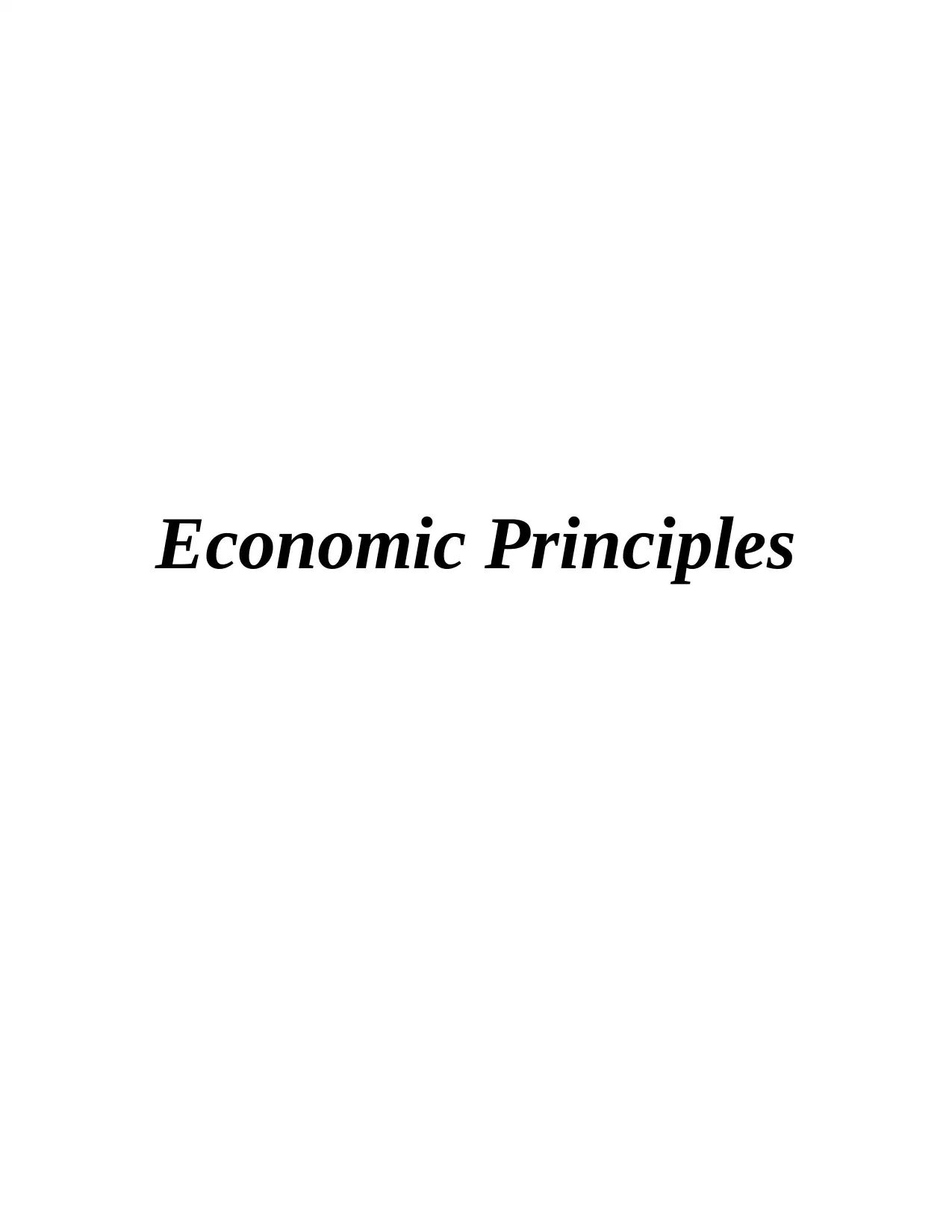
Economic Principles
Paraphrase This Document
Need a fresh take? Get an instant paraphrase of this document with our AI Paraphraser
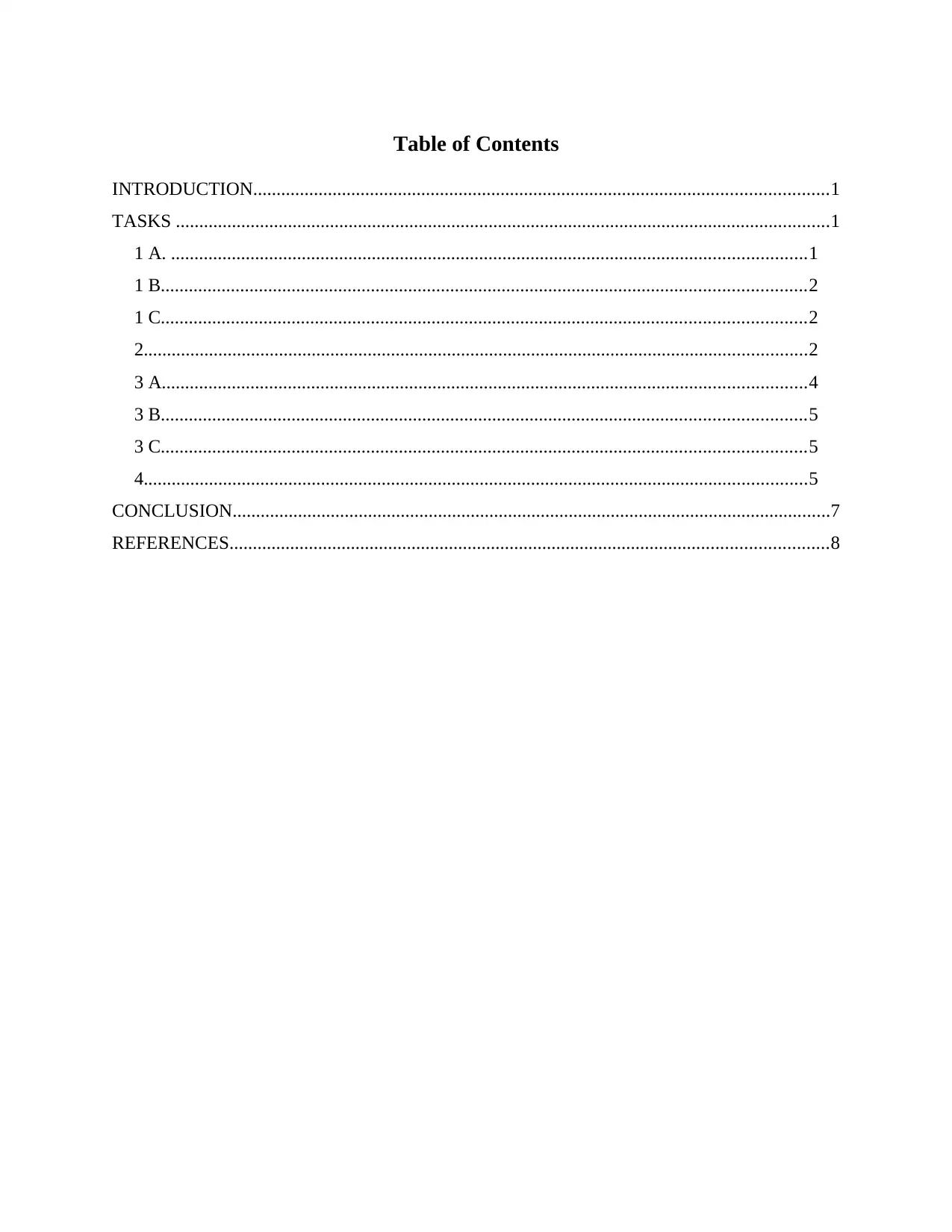
Table of Contents
INTRODUCTION...........................................................................................................................1
TASKS ............................................................................................................................................1
1 A. ........................................................................................................................................1
1 B..........................................................................................................................................2
1 C..........................................................................................................................................2
2..............................................................................................................................................2
3 A..........................................................................................................................................4
3 B..........................................................................................................................................5
3 C..........................................................................................................................................5
4..............................................................................................................................................5
CONCLUSION................................................................................................................................7
REFERENCES................................................................................................................................8
INTRODUCTION...........................................................................................................................1
TASKS ............................................................................................................................................1
1 A. ........................................................................................................................................1
1 B..........................................................................................................................................2
1 C..........................................................................................................................................2
2..............................................................................................................................................2
3 A..........................................................................................................................................4
3 B..........................................................................................................................................5
3 C..........................................................................................................................................5
4..............................................................................................................................................5
CONCLUSION................................................................................................................................7
REFERENCES................................................................................................................................8

⊘ This is a preview!⊘
Do you want full access?
Subscribe today to unlock all pages.

Trusted by 1+ million students worldwide
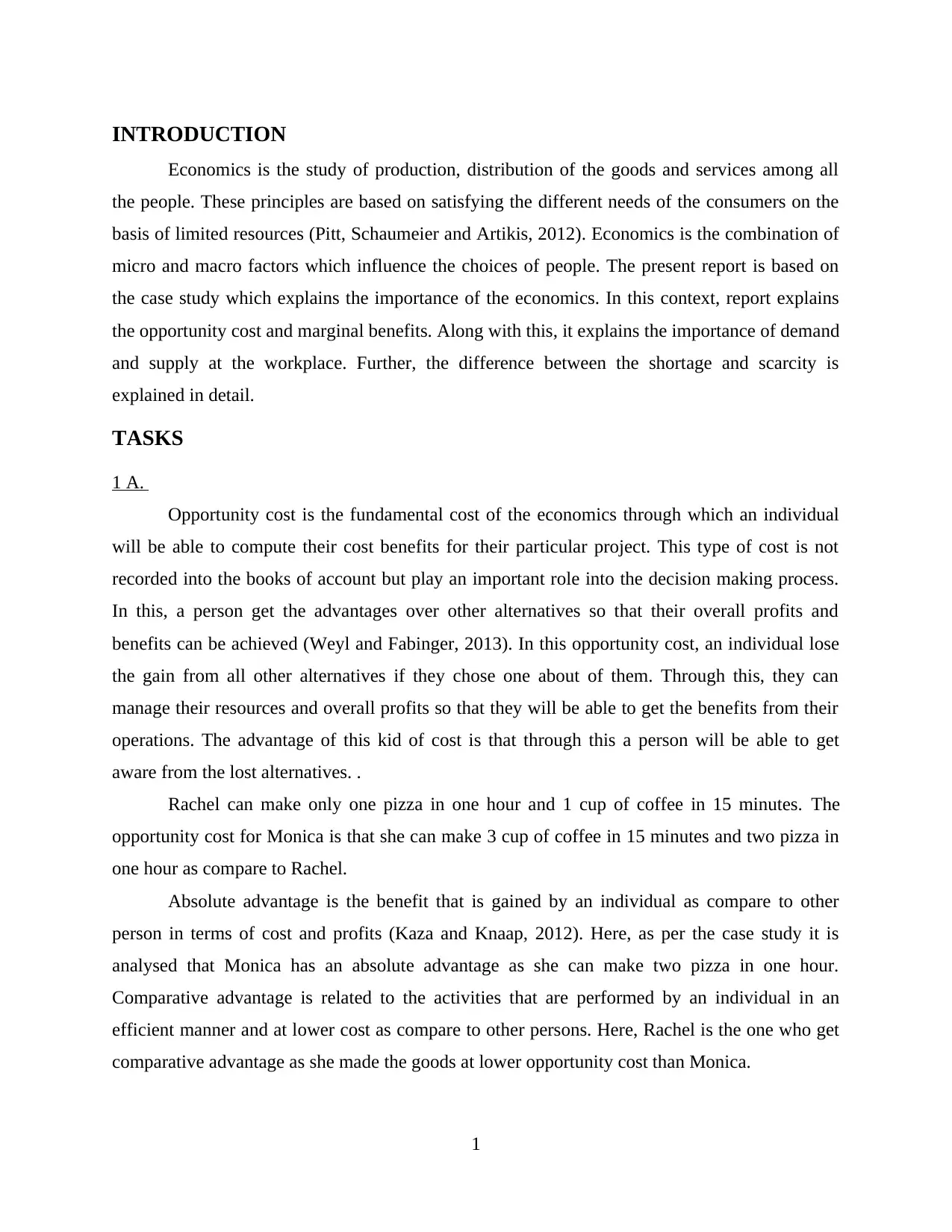
INTRODUCTION
Economics is the study of production, distribution of the goods and services among all
the people. These principles are based on satisfying the different needs of the consumers on the
basis of limited resources (Pitt, Schaumeier and Artikis, 2012). Economics is the combination of
micro and macro factors which influence the choices of people. The present report is based on
the case study which explains the importance of the economics. In this context, report explains
the opportunity cost and marginal benefits. Along with this, it explains the importance of demand
and supply at the workplace. Further, the difference between the shortage and scarcity is
explained in detail.
TASKS
1 A.
Opportunity cost is the fundamental cost of the economics through which an individual
will be able to compute their cost benefits for their particular project. This type of cost is not
recorded into the books of account but play an important role into the decision making process.
In this, a person get the advantages over other alternatives so that their overall profits and
benefits can be achieved (Weyl and Fabinger, 2013). In this opportunity cost, an individual lose
the gain from all other alternatives if they chose one about of them. Through this, they can
manage their resources and overall profits so that they will be able to get the benefits from their
operations. The advantage of this kid of cost is that through this a person will be able to get
aware from the lost alternatives. .
Rachel can make only one pizza in one hour and 1 cup of coffee in 15 minutes. The
opportunity cost for Monica is that she can make 3 cup of coffee in 15 minutes and two pizza in
one hour as compare to Rachel.
Absolute advantage is the benefit that is gained by an individual as compare to other
person in terms of cost and profits (Kaza and Knaap, 2012). Here, as per the case study it is
analysed that Monica has an absolute advantage as she can make two pizza in one hour.
Comparative advantage is related to the activities that are performed by an individual in an
efficient manner and at lower cost as compare to other persons. Here, Rachel is the one who get
comparative advantage as she made the goods at lower opportunity cost than Monica.
1
Economics is the study of production, distribution of the goods and services among all
the people. These principles are based on satisfying the different needs of the consumers on the
basis of limited resources (Pitt, Schaumeier and Artikis, 2012). Economics is the combination of
micro and macro factors which influence the choices of people. The present report is based on
the case study which explains the importance of the economics. In this context, report explains
the opportunity cost and marginal benefits. Along with this, it explains the importance of demand
and supply at the workplace. Further, the difference between the shortage and scarcity is
explained in detail.
TASKS
1 A.
Opportunity cost is the fundamental cost of the economics through which an individual
will be able to compute their cost benefits for their particular project. This type of cost is not
recorded into the books of account but play an important role into the decision making process.
In this, a person get the advantages over other alternatives so that their overall profits and
benefits can be achieved (Weyl and Fabinger, 2013). In this opportunity cost, an individual lose
the gain from all other alternatives if they chose one about of them. Through this, they can
manage their resources and overall profits so that they will be able to get the benefits from their
operations. The advantage of this kid of cost is that through this a person will be able to get
aware from the lost alternatives. .
Rachel can make only one pizza in one hour and 1 cup of coffee in 15 minutes. The
opportunity cost for Monica is that she can make 3 cup of coffee in 15 minutes and two pizza in
one hour as compare to Rachel.
Absolute advantage is the benefit that is gained by an individual as compare to other
person in terms of cost and profits (Kaza and Knaap, 2012). Here, as per the case study it is
analysed that Monica has an absolute advantage as she can make two pizza in one hour.
Comparative advantage is related to the activities that are performed by an individual in an
efficient manner and at lower cost as compare to other persons. Here, Rachel is the one who get
comparative advantage as she made the goods at lower opportunity cost than Monica.
1
Paraphrase This Document
Need a fresh take? Get an instant paraphrase of this document with our AI Paraphraser
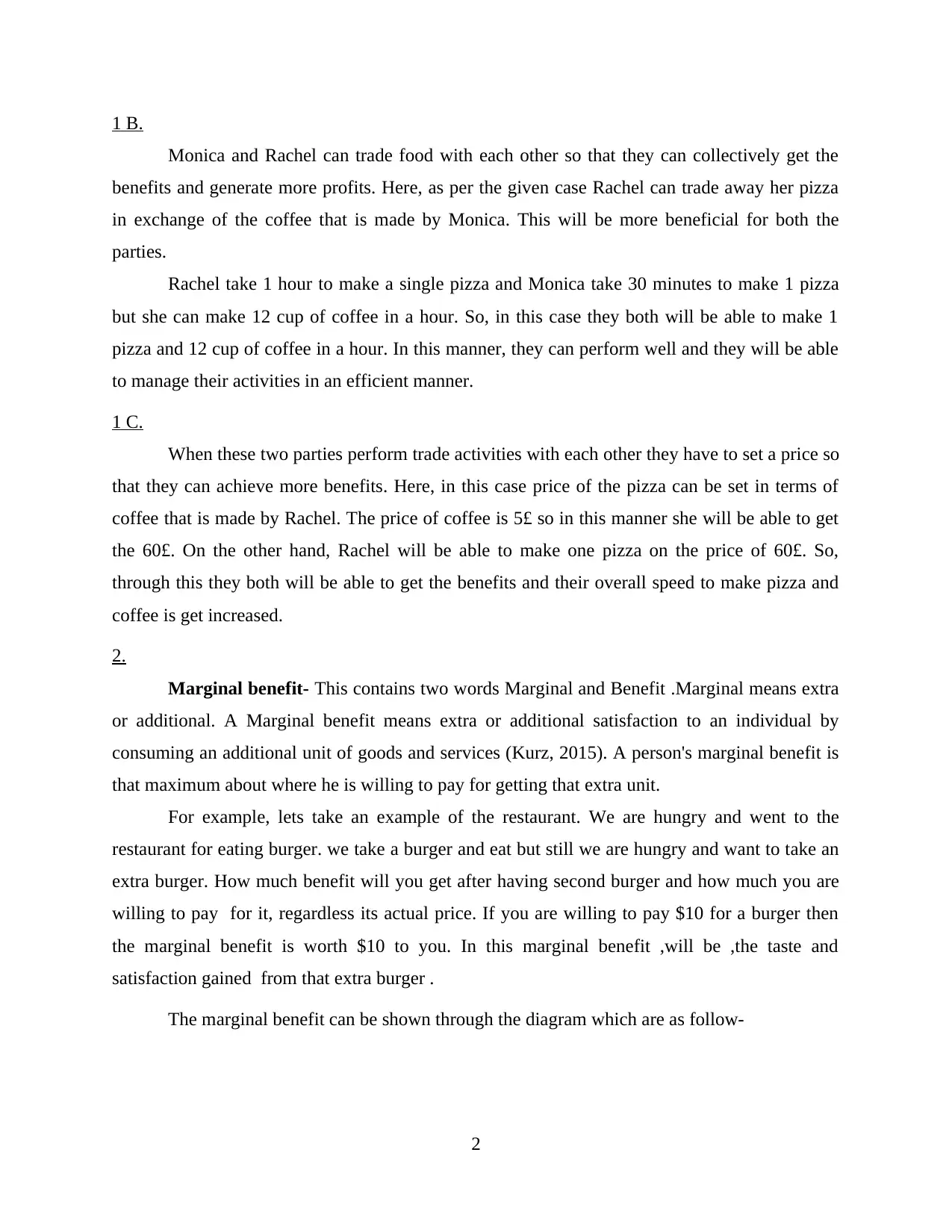
1 B.
Monica and Rachel can trade food with each other so that they can collectively get the
benefits and generate more profits. Here, as per the given case Rachel can trade away her pizza
in exchange of the coffee that is made by Monica. This will be more beneficial for both the
parties.
Rachel take 1 hour to make a single pizza and Monica take 30 minutes to make 1 pizza
but she can make 12 cup of coffee in a hour. So, in this case they both will be able to make 1
pizza and 12 cup of coffee in a hour. In this manner, they can perform well and they will be able
to manage their activities in an efficient manner.
1 C.
When these two parties perform trade activities with each other they have to set a price so
that they can achieve more benefits. Here, in this case price of the pizza can be set in terms of
coffee that is made by Rachel. The price of coffee is 5£ so in this manner she will be able to get
the 60£. On the other hand, Rachel will be able to make one pizza on the price of 60£. So,
through this they both will be able to get the benefits and their overall speed to make pizza and
coffee is get increased.
2.
Marginal benefit- This contains two words Marginal and Benefit .Marginal means extra
or additional. A Marginal benefit means extra or additional satisfaction to an individual by
consuming an additional unit of goods and services (Kurz, 2015). A person's marginal benefit is
that maximum about where he is willing to pay for getting that extra unit.
For example, lets take an example of the restaurant. We are hungry and went to the
restaurant for eating burger. we take a burger and eat but still we are hungry and want to take an
extra burger. How much benefit will you get after having second burger and how much you are
willing to pay for it, regardless its actual price. If you are willing to pay $10 for a burger then
the marginal benefit is worth $10 to you. In this marginal benefit ,will be ,the taste and
satisfaction gained from that extra burger .
The marginal benefit can be shown through the diagram which are as follow-
2
Monica and Rachel can trade food with each other so that they can collectively get the
benefits and generate more profits. Here, as per the given case Rachel can trade away her pizza
in exchange of the coffee that is made by Monica. This will be more beneficial for both the
parties.
Rachel take 1 hour to make a single pizza and Monica take 30 minutes to make 1 pizza
but she can make 12 cup of coffee in a hour. So, in this case they both will be able to make 1
pizza and 12 cup of coffee in a hour. In this manner, they can perform well and they will be able
to manage their activities in an efficient manner.
1 C.
When these two parties perform trade activities with each other they have to set a price so
that they can achieve more benefits. Here, in this case price of the pizza can be set in terms of
coffee that is made by Rachel. The price of coffee is 5£ so in this manner she will be able to get
the 60£. On the other hand, Rachel will be able to make one pizza on the price of 60£. So,
through this they both will be able to get the benefits and their overall speed to make pizza and
coffee is get increased.
2.
Marginal benefit- This contains two words Marginal and Benefit .Marginal means extra
or additional. A Marginal benefit means extra or additional satisfaction to an individual by
consuming an additional unit of goods and services (Kurz, 2015). A person's marginal benefit is
that maximum about where he is willing to pay for getting that extra unit.
For example, lets take an example of the restaurant. We are hungry and went to the
restaurant for eating burger. we take a burger and eat but still we are hungry and want to take an
extra burger. How much benefit will you get after having second burger and how much you are
willing to pay for it, regardless its actual price. If you are willing to pay $10 for a burger then
the marginal benefit is worth $10 to you. In this marginal benefit ,will be ,the taste and
satisfaction gained from that extra burger .
The marginal benefit can be shown through the diagram which are as follow-
2
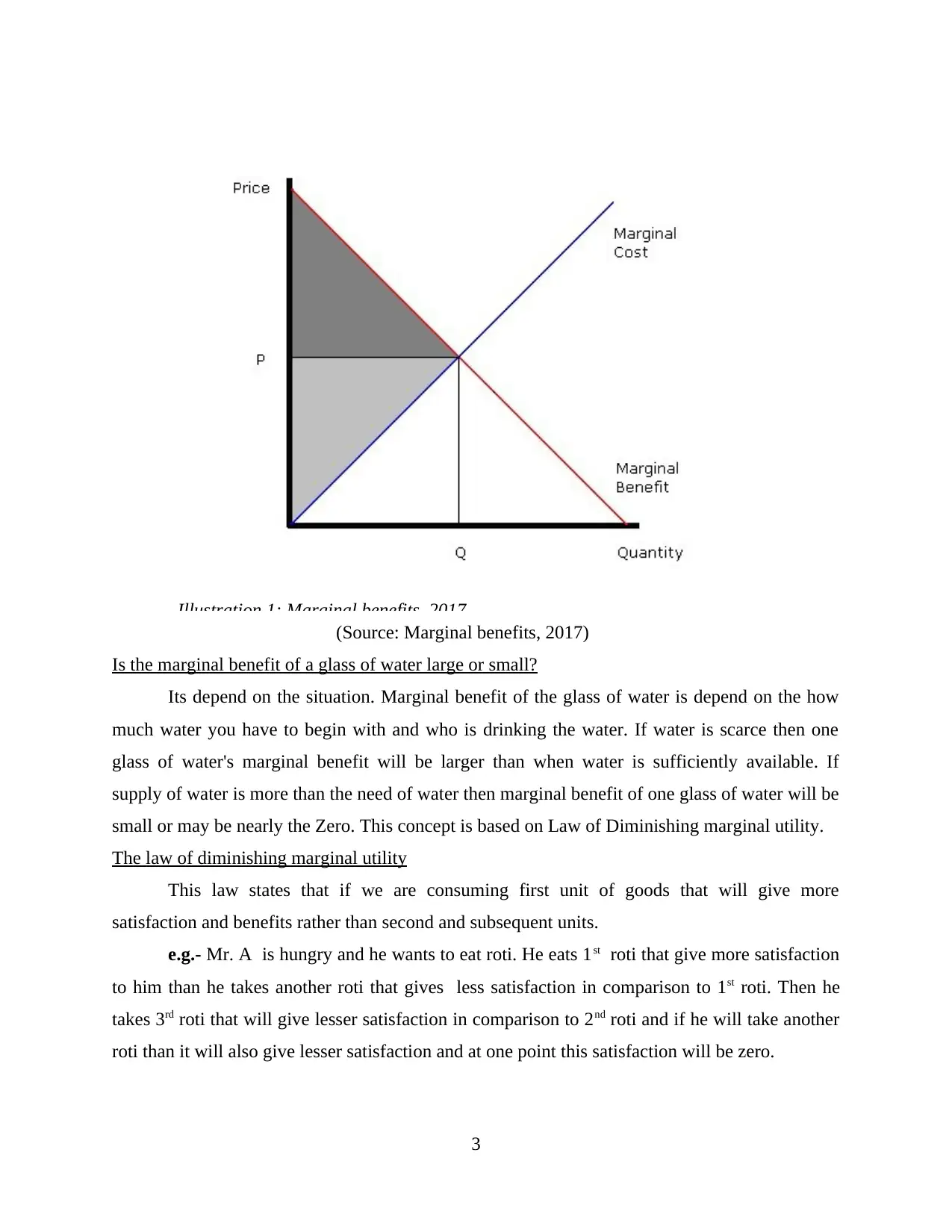
(Source: Marginal benefits, 2017)
Is the marginal benefit of a glass of water large or small?
Its depend on the situation. Marginal benefit of the glass of water is depend on the how
much water you have to begin with and who is drinking the water. If water is scarce then one
glass of water's marginal benefit will be larger than when water is sufficiently available. If
supply of water is more than the need of water then marginal benefit of one glass of water will be
small or may be nearly the Zero. This concept is based on Law of Diminishing marginal utility.
The law of diminishing marginal utility
This law states that if we are consuming first unit of goods that will give more
satisfaction and benefits rather than second and subsequent units.
e.g.- Mr. A is hungry and he wants to eat roti. He eats 1st roti that give more satisfaction
to him than he takes another roti that gives less satisfaction in comparison to 1st roti. Then he
takes 3rd roti that will give lesser satisfaction in comparison to 2nd roti and if he will take another
roti than it will also give lesser satisfaction and at one point this satisfaction will be zero.
3
Illustration 1: Marginal benefits, 2017
Is the marginal benefit of a glass of water large or small?
Its depend on the situation. Marginal benefit of the glass of water is depend on the how
much water you have to begin with and who is drinking the water. If water is scarce then one
glass of water's marginal benefit will be larger than when water is sufficiently available. If
supply of water is more than the need of water then marginal benefit of one glass of water will be
small or may be nearly the Zero. This concept is based on Law of Diminishing marginal utility.
The law of diminishing marginal utility
This law states that if we are consuming first unit of goods that will give more
satisfaction and benefits rather than second and subsequent units.
e.g.- Mr. A is hungry and he wants to eat roti. He eats 1st roti that give more satisfaction
to him than he takes another roti that gives less satisfaction in comparison to 1st roti. Then he
takes 3rd roti that will give lesser satisfaction in comparison to 2nd roti and if he will take another
roti than it will also give lesser satisfaction and at one point this satisfaction will be zero.
3
Illustration 1: Marginal benefits, 2017
⊘ This is a preview!⊘
Do you want full access?
Subscribe today to unlock all pages.

Trusted by 1+ million students worldwide
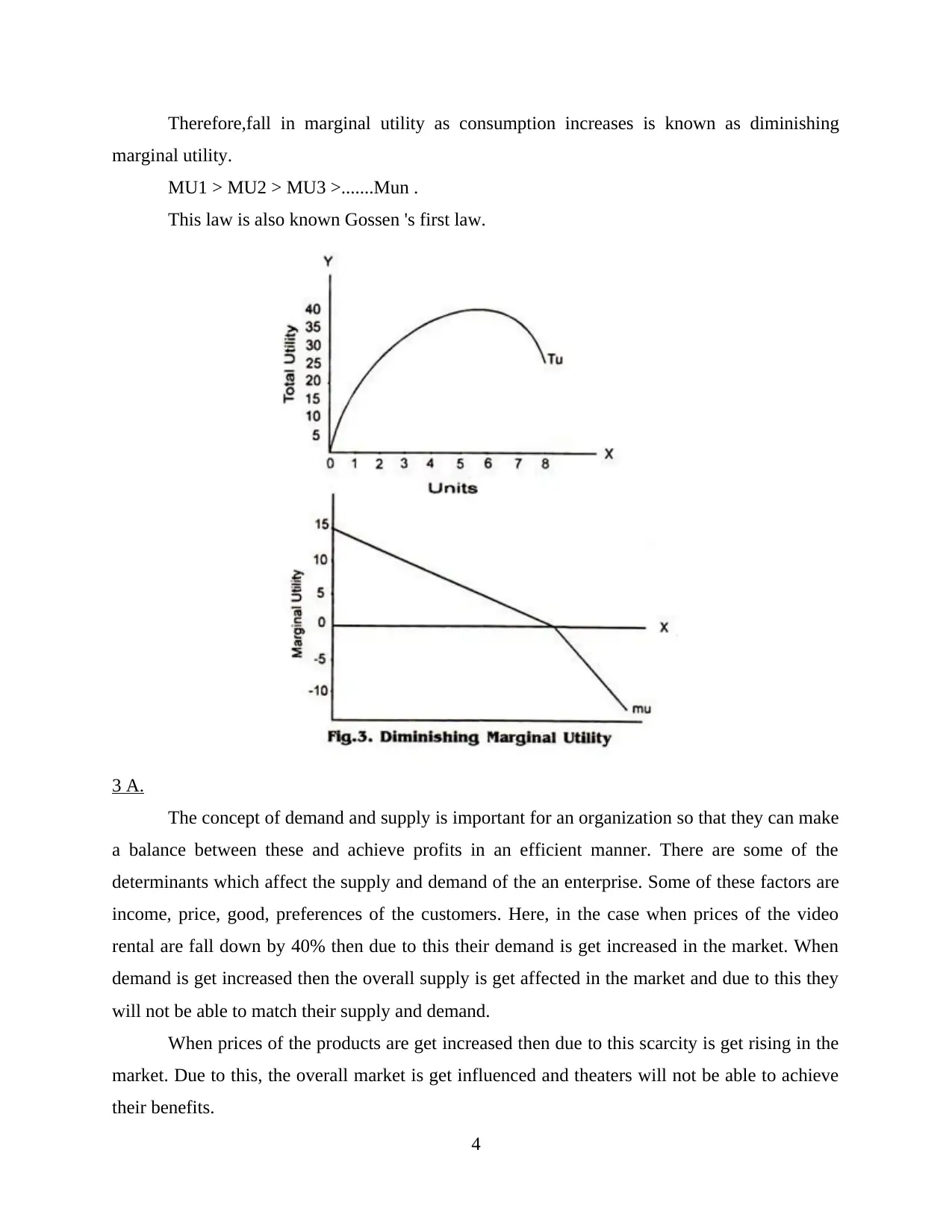
Therefore,fall in marginal utility as consumption increases is known as diminishing
marginal utility.
MU1 > MU2 > MU3 >.......Mun .
This law is also known Gossen 's first law.
3 A.
The concept of demand and supply is important for an organization so that they can make
a balance between these and achieve profits in an efficient manner. There are some of the
determinants which affect the supply and demand of the an enterprise. Some of these factors are
income, price, good, preferences of the customers. Here, in the case when prices of the video
rental are fall down by 40% then due to this their demand is get increased in the market. When
demand is get increased then the overall supply is get affected in the market and due to this they
will not be able to match their supply and demand.
When prices of the products are get increased then due to this scarcity is get rising in the
market. Due to this, the overall market is get influenced and theaters will not be able to achieve
their benefits.
4
marginal utility.
MU1 > MU2 > MU3 >.......Mun .
This law is also known Gossen 's first law.
3 A.
The concept of demand and supply is important for an organization so that they can make
a balance between these and achieve profits in an efficient manner. There are some of the
determinants which affect the supply and demand of the an enterprise. Some of these factors are
income, price, good, preferences of the customers. Here, in the case when prices of the video
rental are fall down by 40% then due to this their demand is get increased in the market. When
demand is get increased then the overall supply is get affected in the market and due to this they
will not be able to match their supply and demand.
When prices of the products are get increased then due to this scarcity is get rising in the
market. Due to this, the overall market is get influenced and theaters will not be able to achieve
their benefits.
4
Paraphrase This Document
Need a fresh take? Get an instant paraphrase of this document with our AI Paraphraser
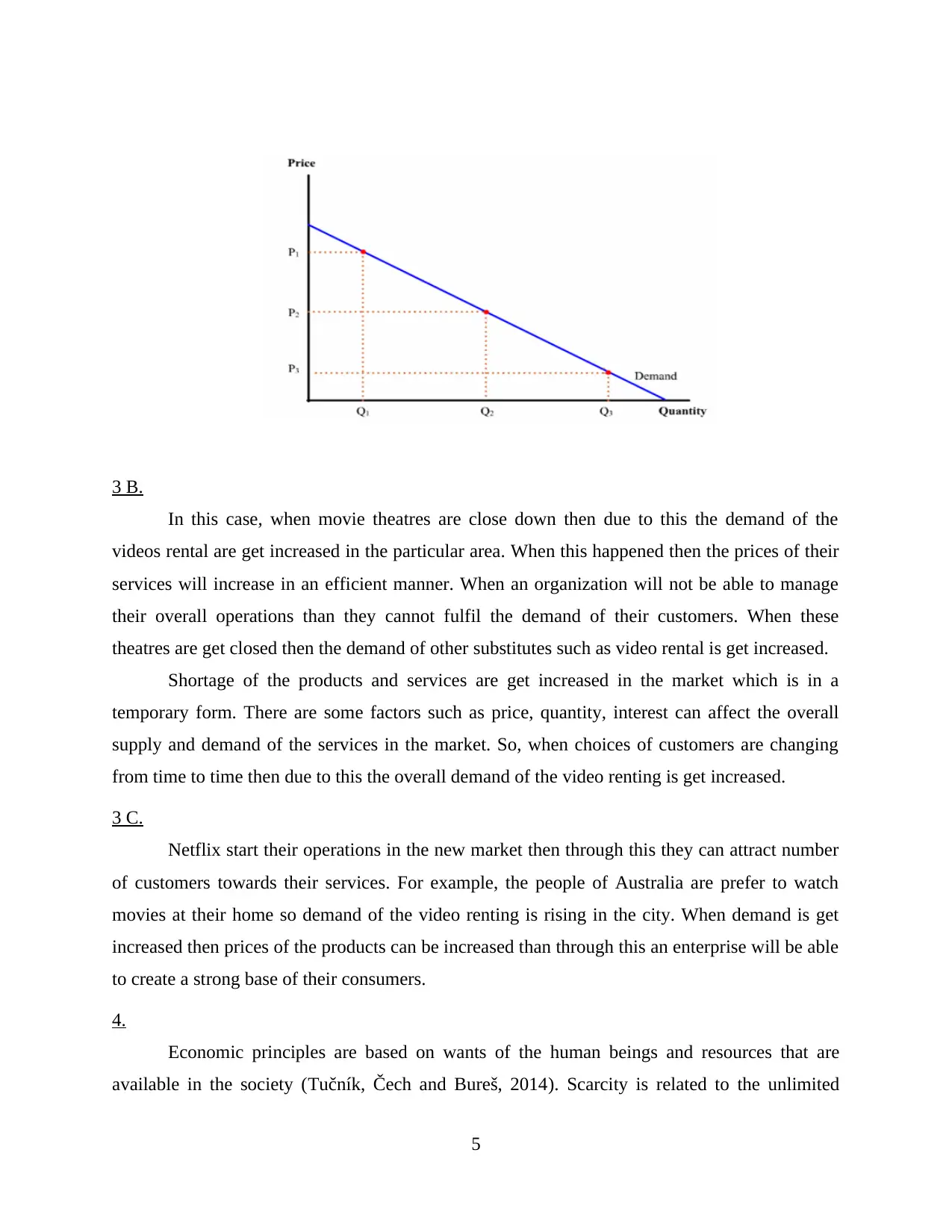
3 B.
In this case, when movie theatres are close down then due to this the demand of the
videos rental are get increased in the particular area. When this happened then the prices of their
services will increase in an efficient manner. When an organization will not be able to manage
their overall operations than they cannot fulfil the demand of their customers. When these
theatres are get closed then the demand of other substitutes such as video rental is get increased.
Shortage of the products and services are get increased in the market which is in a
temporary form. There are some factors such as price, quantity, interest can affect the overall
supply and demand of the services in the market. So, when choices of customers are changing
from time to time then due to this the overall demand of the video renting is get increased.
3 C.
Netflix start their operations in the new market then through this they can attract number
of customers towards their services. For example, the people of Australia are prefer to watch
movies at their home so demand of the video renting is rising in the city. When demand is get
increased then prices of the products can be increased than through this an enterprise will be able
to create a strong base of their consumers.
4.
Economic principles are based on wants of the human beings and resources that are
available in the society (Tučník, Čech and Bureš, 2014). Scarcity is related to the unlimited
5
In this case, when movie theatres are close down then due to this the demand of the
videos rental are get increased in the particular area. When this happened then the prices of their
services will increase in an efficient manner. When an organization will not be able to manage
their overall operations than they cannot fulfil the demand of their customers. When these
theatres are get closed then the demand of other substitutes such as video rental is get increased.
Shortage of the products and services are get increased in the market which is in a
temporary form. There are some factors such as price, quantity, interest can affect the overall
supply and demand of the services in the market. So, when choices of customers are changing
from time to time then due to this the overall demand of the video renting is get increased.
3 C.
Netflix start their operations in the new market then through this they can attract number
of customers towards their services. For example, the people of Australia are prefer to watch
movies at their home so demand of the video renting is rising in the city. When demand is get
increased then prices of the products can be increased than through this an enterprise will be able
to create a strong base of their consumers.
4.
Economic principles are based on wants of the human beings and resources that are
available in the society (Tučník, Čech and Bureš, 2014). Scarcity is related to the unlimited
5
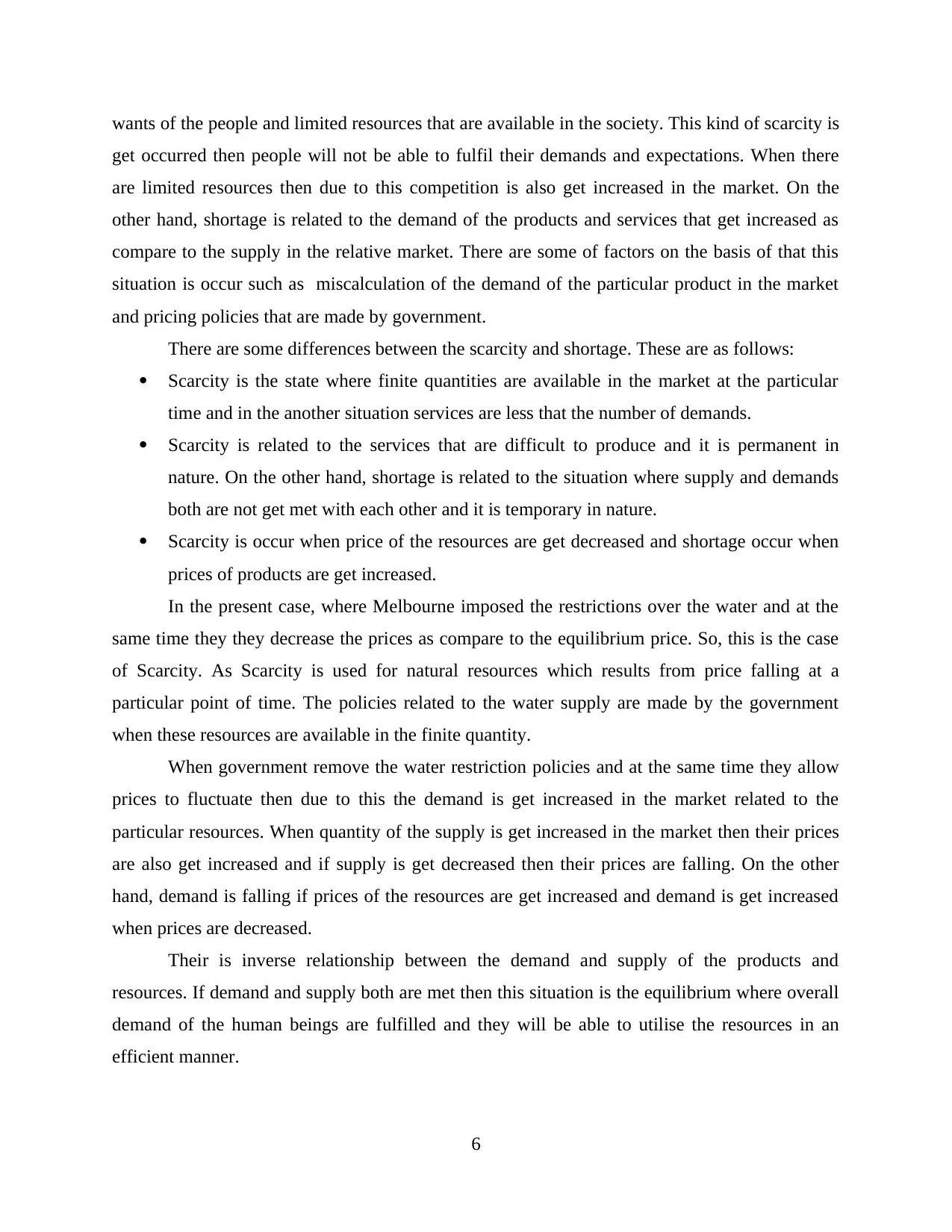
wants of the people and limited resources that are available in the society. This kind of scarcity is
get occurred then people will not be able to fulfil their demands and expectations. When there
are limited resources then due to this competition is also get increased in the market. On the
other hand, shortage is related to the demand of the products and services that get increased as
compare to the supply in the relative market. There are some of factors on the basis of that this
situation is occur such as miscalculation of the demand of the particular product in the market
and pricing policies that are made by government.
There are some differences between the scarcity and shortage. These are as follows:
Scarcity is the state where finite quantities are available in the market at the particular
time and in the another situation services are less that the number of demands.
Scarcity is related to the services that are difficult to produce and it is permanent in
nature. On the other hand, shortage is related to the situation where supply and demands
both are not get met with each other and it is temporary in nature.
Scarcity is occur when price of the resources are get decreased and shortage occur when
prices of products are get increased.
In the present case, where Melbourne imposed the restrictions over the water and at the
same time they they decrease the prices as compare to the equilibrium price. So, this is the case
of Scarcity. As Scarcity is used for natural resources which results from price falling at a
particular point of time. The policies related to the water supply are made by the government
when these resources are available in the finite quantity.
When government remove the water restriction policies and at the same time they allow
prices to fluctuate then due to this the demand is get increased in the market related to the
particular resources. When quantity of the supply is get increased in the market then their prices
are also get increased and if supply is get decreased then their prices are falling. On the other
hand, demand is falling if prices of the resources are get increased and demand is get increased
when prices are decreased.
Their is inverse relationship between the demand and supply of the products and
resources. If demand and supply both are met then this situation is the equilibrium where overall
demand of the human beings are fulfilled and they will be able to utilise the resources in an
efficient manner.
6
get occurred then people will not be able to fulfil their demands and expectations. When there
are limited resources then due to this competition is also get increased in the market. On the
other hand, shortage is related to the demand of the products and services that get increased as
compare to the supply in the relative market. There are some of factors on the basis of that this
situation is occur such as miscalculation of the demand of the particular product in the market
and pricing policies that are made by government.
There are some differences between the scarcity and shortage. These are as follows:
Scarcity is the state where finite quantities are available in the market at the particular
time and in the another situation services are less that the number of demands.
Scarcity is related to the services that are difficult to produce and it is permanent in
nature. On the other hand, shortage is related to the situation where supply and demands
both are not get met with each other and it is temporary in nature.
Scarcity is occur when price of the resources are get decreased and shortage occur when
prices of products are get increased.
In the present case, where Melbourne imposed the restrictions over the water and at the
same time they they decrease the prices as compare to the equilibrium price. So, this is the case
of Scarcity. As Scarcity is used for natural resources which results from price falling at a
particular point of time. The policies related to the water supply are made by the government
when these resources are available in the finite quantity.
When government remove the water restriction policies and at the same time they allow
prices to fluctuate then due to this the demand is get increased in the market related to the
particular resources. When quantity of the supply is get increased in the market then their prices
are also get increased and if supply is get decreased then their prices are falling. On the other
hand, demand is falling if prices of the resources are get increased and demand is get increased
when prices are decreased.
Their is inverse relationship between the demand and supply of the products and
resources. If demand and supply both are met then this situation is the equilibrium where overall
demand of the human beings are fulfilled and they will be able to utilise the resources in an
efficient manner.
6
⊘ This is a preview!⊘
Do you want full access?
Subscribe today to unlock all pages.

Trusted by 1+ million students worldwide
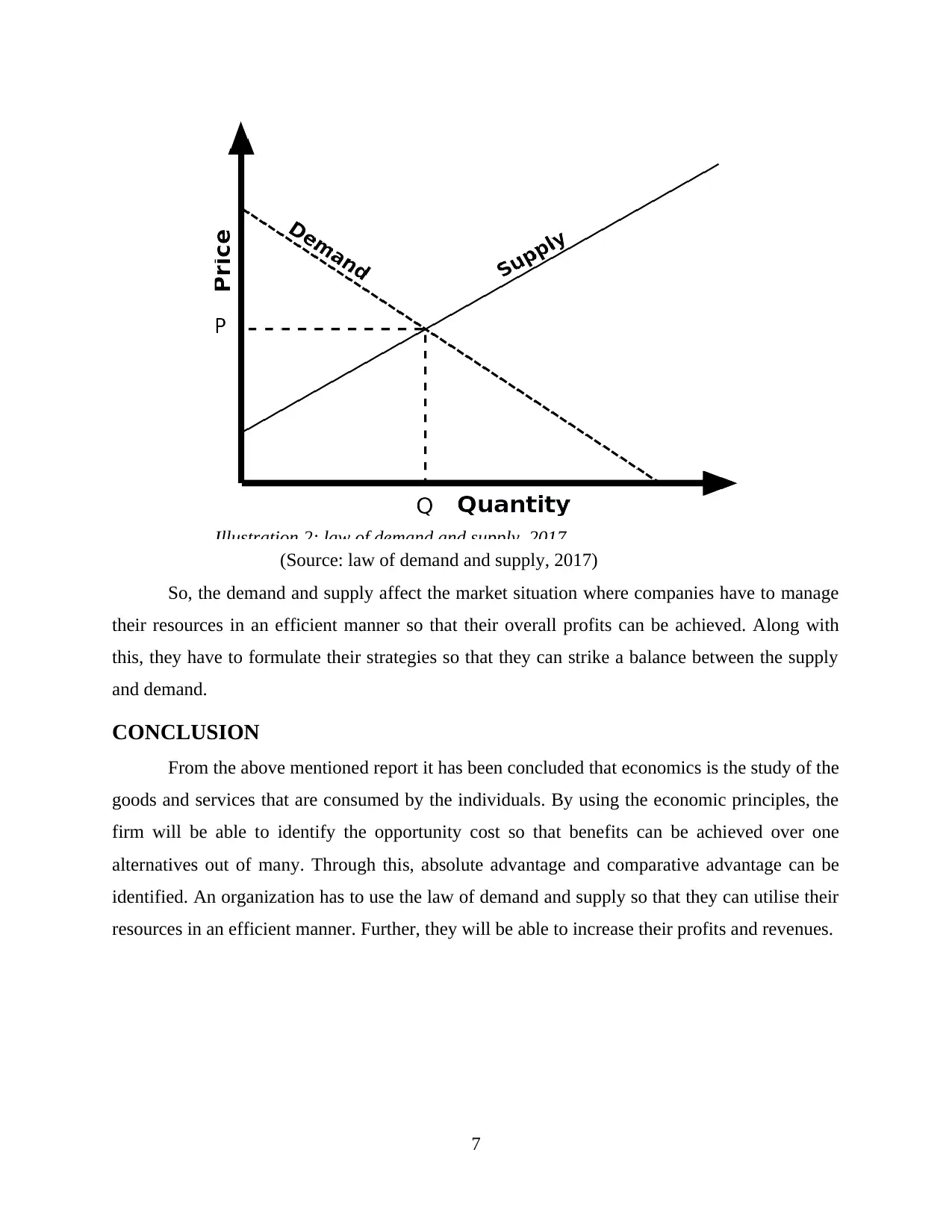
(Source: law of demand and supply, 2017)
So, the demand and supply affect the market situation where companies have to manage
their resources in an efficient manner so that their overall profits can be achieved. Along with
this, they have to formulate their strategies so that they can strike a balance between the supply
and demand.
CONCLUSION
From the above mentioned report it has been concluded that economics is the study of the
goods and services that are consumed by the individuals. By using the economic principles, the
firm will be able to identify the opportunity cost so that benefits can be achieved over one
alternatives out of many. Through this, absolute advantage and comparative advantage can be
identified. An organization has to use the law of demand and supply so that they can utilise their
resources in an efficient manner. Further, they will be able to increase their profits and revenues.
7
Illustration 2: law of demand and supply, 2017
So, the demand and supply affect the market situation where companies have to manage
their resources in an efficient manner so that their overall profits can be achieved. Along with
this, they have to formulate their strategies so that they can strike a balance between the supply
and demand.
CONCLUSION
From the above mentioned report it has been concluded that economics is the study of the
goods and services that are consumed by the individuals. By using the economic principles, the
firm will be able to identify the opportunity cost so that benefits can be achieved over one
alternatives out of many. Through this, absolute advantage and comparative advantage can be
identified. An organization has to use the law of demand and supply so that they can utilise their
resources in an efficient manner. Further, they will be able to increase their profits and revenues.
7
Illustration 2: law of demand and supply, 2017
Paraphrase This Document
Need a fresh take? Get an instant paraphrase of this document with our AI Paraphraser
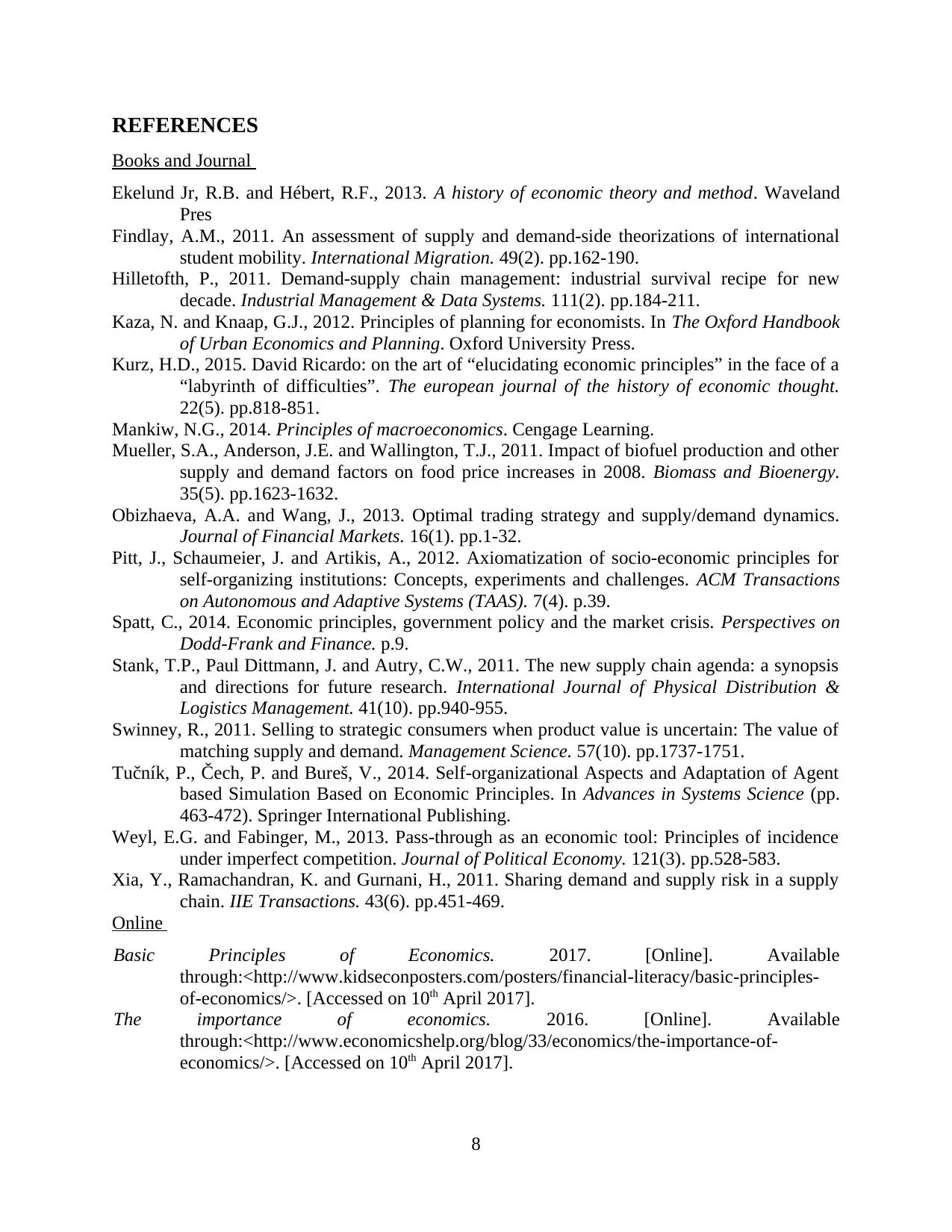
REFERENCES
Books and Journal
Ekelund Jr, R.B. and Hébert, R.F., 2013. A history of economic theory and method. Waveland
Pres
Findlay, A.M., 2011. An assessment of supply and demand‐side theorizations of international
student mobility. International Migration. 49(2). pp.162-190.
Hilletofth, P., 2011. Demand-supply chain management: industrial survival recipe for new
decade. Industrial Management & Data Systems. 111(2). pp.184-211.
Kaza, N. and Knaap, G.J., 2012. Principles of planning for economists. In The Oxford Handbook
of Urban Economics and Planning. Oxford University Press.
Kurz, H.D., 2015. David Ricardo: on the art of “elucidating economic principles” in the face of a
“labyrinth of difficulties”. The european journal of the history of economic thought.
22(5). pp.818-851.
Mankiw, N.G., 2014. Principles of macroeconomics. Cengage Learning.
Mueller, S.A., Anderson, J.E. and Wallington, T.J., 2011. Impact of biofuel production and other
supply and demand factors on food price increases in 2008. Biomass and Bioenergy.
35(5). pp.1623-1632.
Obizhaeva, A.A. and Wang, J., 2013. Optimal trading strategy and supply/demand dynamics.
Journal of Financial Markets. 16(1). pp.1-32.
Pitt, J., Schaumeier, J. and Artikis, A., 2012. Axiomatization of socio-economic principles for
self-organizing institutions: Concepts, experiments and challenges. ACM Transactions
on Autonomous and Adaptive Systems (TAAS). 7(4). p.39.
Spatt, C., 2014. Economic principles, government policy and the market crisis. Perspectives on
Dodd-Frank and Finance. p.9.
Stank, T.P., Paul Dittmann, J. and Autry, C.W., 2011. The new supply chain agenda: a synopsis
and directions for future research. International Journal of Physical Distribution &
Logistics Management. 41(10). pp.940-955.
Swinney, R., 2011. Selling to strategic consumers when product value is uncertain: The value of
matching supply and demand. Management Science. 57(10). pp.1737-1751.
Tučník, P., Čech, P. and Bureš, V., 2014. Self-organizational Aspects and Adaptation of Agent
based Simulation Based on Economic Principles. In Advances in Systems Science (pp.
463-472). Springer International Publishing.
Weyl, E.G. and Fabinger, M., 2013. Pass-through as an economic tool: Principles of incidence
under imperfect competition. Journal of Political Economy. 121(3). pp.528-583.
Xia, Y., Ramachandran, K. and Gurnani, H., 2011. Sharing demand and supply risk in a supply
chain. IIE Transactions. 43(6). pp.451-469.
Online
Basic Principles of Economics. 2017. [Online]. Available
through:<http://www.kidseconposters.com/posters/financial-literacy/basic-principles-
of-economics/>. [Accessed on 10th April 2017].
The importance of economics. 2016. [Online]. Available
through:<http://www.economicshelp.org/blog/33/economics/the-importance-of-
economics/>. [Accessed on 10th April 2017].
8
Books and Journal
Ekelund Jr, R.B. and Hébert, R.F., 2013. A history of economic theory and method. Waveland
Pres
Findlay, A.M., 2011. An assessment of supply and demand‐side theorizations of international
student mobility. International Migration. 49(2). pp.162-190.
Hilletofth, P., 2011. Demand-supply chain management: industrial survival recipe for new
decade. Industrial Management & Data Systems. 111(2). pp.184-211.
Kaza, N. and Knaap, G.J., 2012. Principles of planning for economists. In The Oxford Handbook
of Urban Economics and Planning. Oxford University Press.
Kurz, H.D., 2015. David Ricardo: on the art of “elucidating economic principles” in the face of a
“labyrinth of difficulties”. The european journal of the history of economic thought.
22(5). pp.818-851.
Mankiw, N.G., 2014. Principles of macroeconomics. Cengage Learning.
Mueller, S.A., Anderson, J.E. and Wallington, T.J., 2011. Impact of biofuel production and other
supply and demand factors on food price increases in 2008. Biomass and Bioenergy.
35(5). pp.1623-1632.
Obizhaeva, A.A. and Wang, J., 2013. Optimal trading strategy and supply/demand dynamics.
Journal of Financial Markets. 16(1). pp.1-32.
Pitt, J., Schaumeier, J. and Artikis, A., 2012. Axiomatization of socio-economic principles for
self-organizing institutions: Concepts, experiments and challenges. ACM Transactions
on Autonomous and Adaptive Systems (TAAS). 7(4). p.39.
Spatt, C., 2014. Economic principles, government policy and the market crisis. Perspectives on
Dodd-Frank and Finance. p.9.
Stank, T.P., Paul Dittmann, J. and Autry, C.W., 2011. The new supply chain agenda: a synopsis
and directions for future research. International Journal of Physical Distribution &
Logistics Management. 41(10). pp.940-955.
Swinney, R., 2011. Selling to strategic consumers when product value is uncertain: The value of
matching supply and demand. Management Science. 57(10). pp.1737-1751.
Tučník, P., Čech, P. and Bureš, V., 2014. Self-organizational Aspects and Adaptation of Agent
based Simulation Based on Economic Principles. In Advances in Systems Science (pp.
463-472). Springer International Publishing.
Weyl, E.G. and Fabinger, M., 2013. Pass-through as an economic tool: Principles of incidence
under imperfect competition. Journal of Political Economy. 121(3). pp.528-583.
Xia, Y., Ramachandran, K. and Gurnani, H., 2011. Sharing demand and supply risk in a supply
chain. IIE Transactions. 43(6). pp.451-469.
Online
Basic Principles of Economics. 2017. [Online]. Available
through:<http://www.kidseconposters.com/posters/financial-literacy/basic-principles-
of-economics/>. [Accessed on 10th April 2017].
The importance of economics. 2016. [Online]. Available
through:<http://www.economicshelp.org/blog/33/economics/the-importance-of-
economics/>. [Accessed on 10th April 2017].
8

9
⊘ This is a preview!⊘
Do you want full access?
Subscribe today to unlock all pages.

Trusted by 1+ million students worldwide
1 out of 12
Related Documents
Your All-in-One AI-Powered Toolkit for Academic Success.
+13062052269
info@desklib.com
Available 24*7 on WhatsApp / Email
![[object Object]](/_next/static/media/star-bottom.7253800d.svg)
Unlock your academic potential
Copyright © 2020–2025 A2Z Services. All Rights Reserved. Developed and managed by ZUCOL.




